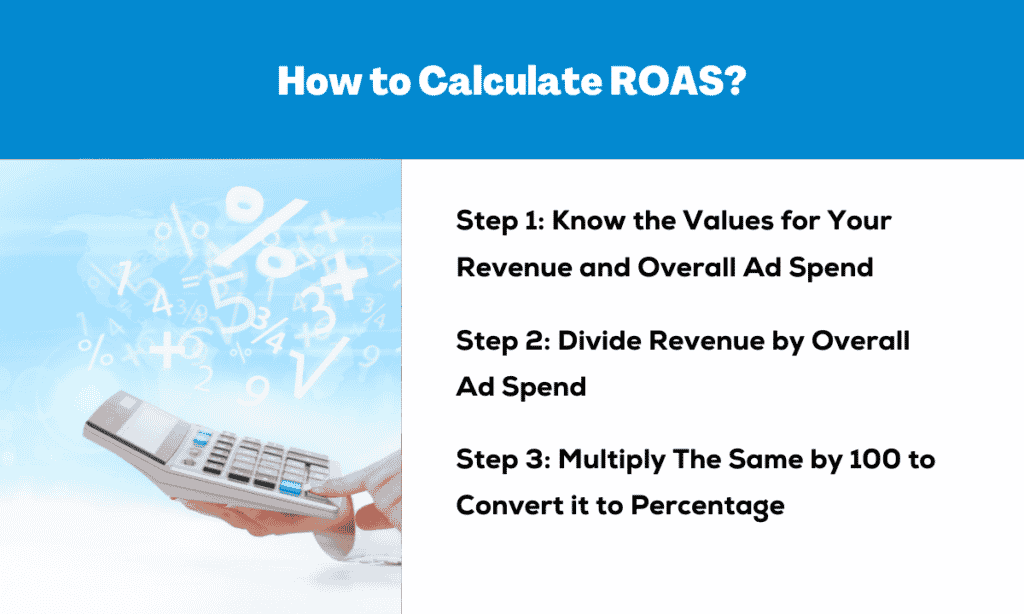
When it comes to measuring the success of your advertising campaigns, there are various metrics that you need to keep track of. For spending, however, ROAS is likely the most important metric.
In the course of an advertisement campaign, there are several moving pieces you need to keep track of actively. Although there are several metrics that play a crucial role in determining your business’s overall success, conversion is the bottom line in advertising campaigns.
While conversions, on the whole, may seem to be gaining traction with several more sales activities taking place, the truth is more complex. For example, your overall investment in the campaign may have been half your overall profit.
Why is this bad? Well from a bird’s eye view you’re still getting profit, however, a huge chunk is being directed towards ads. That’s why for users, to accurately measure their campaign performance, it mostly comes down to making sure you calculate ROAS.
What Is ROAS?
ROAS or Return On Ad Spend is a metric that helps digital marketers understand the effectiveness of their campaign or your ads spread for over a year. ROAS enables you to understand how much you’ve spent on advertisements and compare that with the revenue you’ve made for a specific period of time.
It’s essential to keep in mind that ROAS does not take into account overhead costs that arise in the course of business. So, while making sure you calculate ROAS is a good indicator of the effectiveness of your campaign, it’s vital to keep in mind that it does not take into account the overall success or profitability of your business.
Why Is ROAS Important?
To put it simply, it comes down to the allocation of advertising spending. When spending money on ads you can allot a specific amount on PPC and also on display ads based on the ad revenue generated.
Say for example you spend $5000 on PPC and $5000 on display ads. After your campaign, when calculating ROAS, you find that PPC gave you only a 200% return on ad spend. However, you find that the display ads gave you a 400% return on ad spend.
This way you understand which avenue is more effective and can revise your plan considering this. Based on which generates more revenue, you can redirect your budget and ad spend accordingly.
How to Calculate ROAS?
Step 1: First Calculate ROAS
Calculating your ROAS is fairly simple, first, you need to know your overall revenue, After this, you need to divide this amount by your overall ad spend and multiply the same by 100. The metrics for this, you should be able to get from your Google Analytics, Facebook, or Amazon Ads account.

For example:
Say your revenue is $27,000 and your overall ad spend is $10,000.
Your ROAS would be:
27,000/10,000 x 100 = 270%
You almost managed to triple the overall amount spent on ads.
That said, the success of your campaign depends entirely on your profit margin. So in order to have a successful campaign, you need to understand how much revenue you should be making. But besides that, the steps mentioned above are a pretty clear guide on how to calculate ROAS.
Step 2: Calculate Your ROAS Goal
Figuring out how to calculate your ROAS goal is quite straightforward, it all comes down to how much money you make after taking into account all your business expenditures. Business expenses are things like your office rental, employees’ salary, electricity bills, and various other expenses that need to be paid.
For example, after paying for expenses at your business, you’re left with 30% of the money you’ve earned, and your profit margin is 30%.
Calculate Profit Margin
To calculate your profit margin, you just need to divide your profit by your overall revenue and multiply it by 100. For example, if you earned 30,000 but have a profit of 10,000 your profit margin would look like this:
10,000/30,000 x 100 = 33.33%
Calculate Your ROAS Goal
Keeping in mind your profit margin, you need to make sure you calculate your overall ROAS, so your business expenditures are covered and your ad spend stays profitable for your business.
If you have a profit margin of 20%, you would need to ensure your revenue covers this plus the remaining 80%, which is your expenditure. So, for things to stay profitable, your minimum ROAS goal should be:
Profit Margin / 100 multiplied by 100
25/100 x 100 = 400%
This means you need to ensure that your overall ROAS goal is a minimum of 400%.
Step 3: Calculate Your ROAS Across Individual Channels to See Which Is Most Profitable
After this, you can look into your individual advertising avenues to see which one is the most profitable. To this, you can compare revenue attributed and overall spend in that one individual field.
For example, if you spent $5000 on Facebook and, using your analytics, you find that you have $15000 revenue (300% ROAS).
On the other hand, you may find out that the same $5000 spent on Google Ads only gave you $12,000 in revenue (240% ROAS).
In this case, shifting your strategy to one that focuses primarily on Facebook ads may be more profitable for your business.
What Can You Measure with ROAS?
ROAS covers various avenues, and for digital marketing experts, it can help in measuring some of the aspects listed below:
Advertisements
The effectiveness of ads run through various platforms, like Google, Facebook, and even Linkedin. This can help users understand how effective the response is from the audience they’re targeting.
A Campaign’s Success
An advertising campaign comprises various avenues targeted with varied media mix. Making it a point to calculate ROAS helps users understand which avenue is most effective, and can help them double down their efforts with the one that is most profitable.
Ad Groups
When it comes to advertising, often, you run specific advertisements targeting a specific target audience. So, while targeting varied ad groups, you understand which one is most profitable and responsive to your product or service.
Keywords
When bidding on keywords, there are various factors that come into play where competitiveness and your campaign budget play a crucial role. That said, understanding which keywords helped generate revenue can help you reassess and build your next campaign.
Calculating ROAS – Things to Remember
While there are so many things to keep track of while executing a digital marketing strategy, making sure you calculate ROAS should be among the top priorities when it comes to your digital ads. Although overall conversions and site traffic are other things to keep in mind, are equally if not more important. Generally, your ROAS should be a metric you track during and after your campaign to ensure your business stays healthy.
With many marketing experts out there, and several different things that come into play, keeping in mind things like attribution and even your customer’s life cycle are also important. That said, we’ve covered most of what you need to know about how to calculate ROAS. Did you find this article helpful? Let us know in the comments below!
Frequently Asked Questions
What is the difference between ROAS vs. ROI?
While ROAS evaluates the effectiveness of your revenue in relation to ad spend, ROI focuses on the overall business expenditure and profits earned while taking into account all the overhead costs. ROAS is effective when calculating whether your advertising efforts are healthy, however, ROI keeps in mind the overall success of your business.
Is calculating your ROAS important?
Yes! When it comes to digital marketing campaigns, calculating your ROAS is necessary to assess the overall effectiveness and profitability of your marketing campaign.


